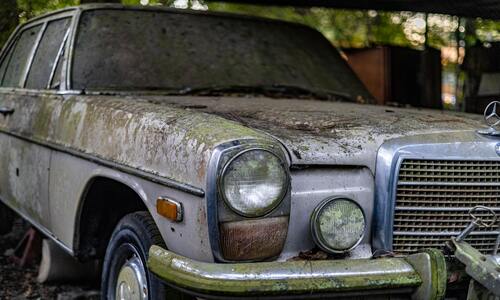You’ve heard of mold growing on a car interior after a beverage spill or water damage, but never the exterior of your vehicle. Yet those spots on the paint job look a lot like mold spores, in your humble opinion. How do you remove and prevent mold on your car’s exterior?
To remove car exterior mold, use a soft brush for plastic and rubber and then a high-pressure hose and a microfiber cloth to clean away mold residue on the rest of the vehicle’s exterior. To prevent mold, always close the windows and doors when your car is not in use.
A moldy car can put a damper on your driving experience, but it needn’t for long. Keep reading for helpful information on identifying, removing, and preventing mold on your car’s exterior.

Related articles
How To Remove Mold In A Car: 4 Easy Steps
How To Clean Car Window Seal Mold In Four Simple Steps
How To Prevent Mold When Storing A Car In Four Easy Steps
Mold And Odour In Car AC Vents: How To Clean And Prevent
What Causes Mold and Algae to Grow on Cars?
The discoloration you see on your car’s exterior can be more than mere mold but algae as well.
Why have these fungi and plant matter taken up residence on the exterior of your car?
Let’s begin by discussing mold first. Mold will grow on nearly any type of surface, which you’ll recall if you regularly read this blog.
Since mold is not picky, that means your car’s exterior (and its interior as well) is not off-limits. By creating a humid, damp environment, mold will grow.
Algae is a problem that only occurs on a car’s exterior, as algae prefer stagnant conditions such as still water as well as hot temperatures.
How to Kill and Remove Mold and Algae on Your Car
The mold and algae on your car’s exterior have stolen its beauty and shine away.
You’re embarrassed to drive the car to work, to park it in your driveway, and to be seen with it just about anywhere.
It’s time to treat the mold and algae issue. Here are the steps to follow.
Step 1 – Start by Washing the Car’s Exterior
You needn’t reach for any heavy-duty cleaning methods yet when simpler strategies might suffice.
As you would when washing your car any other time, fill a bucket with soapy water, dip a sponge into the water, and focus on the splotchy areas of your car’s exterior that are riddled with algae and mold.
You might not be able to remove everything, but you should be able to get at least some of the mold and algae off your vehicle.
Step 2 – Apply a Car Shampoo and Scour
If water and mild dish soap alone left too much mold and algae residue for you to be pleased, it’s time to move on to phase two of your plan.
Use a little bit of car shampoo and then begin scouring with a microfiber mitt or cloth.
You’re not trying to put too much pressure on your car exterior. Although microfiber won’t scratch the paint, you still want to watch the amount of force you use.
Step 3 – Use Isopropyl Alcohol
Strong cleaners such as bleach are a poor choice for your vehicle’s exterior since the bleach can irreparably damage the paint job or other surfaces.
The strongest cleaner you should reach for if you must is isopropyl alcohol.
Dilute the isopropyl alcohol with water, put the fluids in a spray bottle, and mist the affected parts of your car.
After five minutes elapse, use a clean, wet cloth to remove all residue of the isopropyl alcohol.
Step 4 – Finish with a High-Pressure Hose
Perhaps even after doing the above, you still have stubborn mold or algae spores lingering on the exterior of your car.
Rather than get frustrated and keep repeating Steps 1, 2, and 3 ad infinitum, it’s time to pull out the big guns.
Unfurl your highest-pressure hose, turn the water on, and blast the exterior.
You should only do this for the painted areas of your car, not the trim, seals, or windows. You could rip the seals clean off and possibly even break the windows depending on how strong the water is.
Don’t hold the hose in one spot for too long. Rather, guide the water across the moldy areas of your exterior and then repeat.
By the time you turn the hose off, the mold and algae residue should be gone.
From there, you might wish to wash your entire car, dry it, and wax it to perfection.
How to Remove Mold from Your Window Trim
What if your problem isn’t so much mold on your car’s paint job but on the window trim?
As we established in the section prior, some of the methods above will not work for the trim, so what should you do?
You definitely don’t want a high-pressure hose, that’s for certain.
Instead, you should reach for a soft brush.
Please wet the area so you don’t end up scraping the window trim with the brush! You should also coat the brush with car shampoo so the bristles are softer.
Applying gentle yet firm pressure, work the brush in the plastic or rubber window trim until you remove the algae and mold spores from this part of your vehicle’s exterior.
It might take repeated attempts before you’re successful, but it will happen.
Once the mold or algae spores are gone, wipe down the area with a clean, damp microfiber cloth.
How to Prevent Mold and Algae from Growing on Your Car
Dealing with mold or algae on your car once was more than enough. Your vehicle got out of it unscathed, but you want to keep your vehicle in ready-to-use, mold-free condition for a long time to come. How do you do it?
Here are our top recommendations.
Watch Where You Park
When not in use, where do you park your car?
Is it out in the open or under an awning that can spill deluges of rain in the event of inclement weather? Is the vehicle in a stuffy, enclosed parking garage?
You’ll recall that both algae and mold prefer warm environments, and mold especially likes moist and damp places as well.
Don’t give mold and algae the chance to grow. Park your car out in the open where the sun can shine on it and kill off spores.
Don’t Ignore Water in the Vehicle
If you have a spill in your car, take the time to seep it up immediately. It can take time and some aeration before the interior is fully dry, but then you can rest easy.
What does this have to do with the exterior of your car, you ask? Mold spores can travel. If you have a spill on one of the seats, the spores could settle in the window trim and spread from there.
You’ll have mold and possibly algae on both the inside and outside of your vehicle.
Don’t Leave Windows and Doors Open
It’s one thing if you’re airing out your vehicle after a water spill inside. In any other instances though, you want to keep the doors and windows completely closed and locked.
This does more than prohibit water from getting in and possibly causing mold. You’re also making your vehicle more theft-proof.
What Are the Black Spots on Your Car? What About Green Spots?
You’ve seen a smattering of black spots across your vehicle’s exterior. Before now, you had assumed it must have been dirt.
Then you tried rubbing the spot away and they didn’t budge easily. You’re starting to wonder if the black spots on your vehicle could be mold, but is that possible?
It is indeed possible! Black mold spores can cross-contaminate from the outdoors or your home and land on the car.
The same goes for green mold.
However, keep in mind that while mold comes in an assortment of colors, algae is always green.
Thus, the green discoloration on your vehicle can be either algae or mold. Your removal methods are the same either way.
Conclusion
Mold on the exterior of your car makes for quite an unappealing ride, and it’s not great to spend time in such close proximity to mold either.
Now that you know how to remove both mold and algae from your car’s exterior, you can enjoy a cleaner car that you’re proud to drive.

